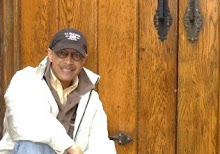
I spent almost a decade living and working in Europe as a freelance photographer and even though I have not owned a camera in over 15 years, photography and the many aspects of the art still fasinate me. That's why a recent AP article caught my eye:
An 1839 daguerreotype camera, ancestor of modern photography, was sold at auction in Vienna Saturday for nearly 600,000 euros making it the world's oldest and most expensive commercial photographic apparatus.
An anonymous buyer paid 588,613 euros (792,000 dollars), bidding by Internet, said the Galerie Westlicht auction house.
The opening price was 100,000 euros for the wooden box structure, which is in its original state and had been lying forgotten in a loft in Munich since the year 1940 until the present owner of the premises accidentally came across it.
The daguerreotype is an early type of photograph in which the image is exposed directly onto a mirror-polished surface of silver bearing a coating of silver halide particles deposited by iodine vapor. In later developments bromine and chlorine vapors were also used, resulting in shorter exposure times. Unlike later photographic processes that supplanted it, the daguerreotype is a direct positive image-making process with no "negative" original.
The daguerreotype is named after one of its inventors, French artist and chemist Louis J.M. Daguerre, who announced its perfection in 1839 after years of research and collaboration with Joseph Nicéphore Niépce, applying and extending a discovery by Johann Heinrich Schultz (1724): a silver and chalk mixture darkens when exposed to light. The French Academy of Sciences announced the daguerreotype process on January 9 of that year. Even today, daguerreotypy continues to be practiced by enthusiastic photographers which are thought to be fewer than 100 worldwide. Its appeal lies in the "magic mirror" effect of light reflected from the polished silver plate through the perfectly sharp silver image, and in the sense of achievement derived from the dedication and hand-crafting required to make a daguerreotype. Picture that, next time you pick up your digital camera. Take a closer look at the 725 photographs in an amazing daguerreotype collection at the Library Of Congress at: www.memory.loc.gov/ammem/daghtml/daghome.html
Research info provided by: www.wikipedia.org
An 1839 daguerreotype camera, ancestor of modern photography, was sold at auction in Vienna Saturday for nearly 600,000 euros making it the world's oldest and most expensive commercial photographic apparatus.
An anonymous buyer paid 588,613 euros (792,000 dollars), bidding by Internet, said the Galerie Westlicht auction house.
The opening price was 100,000 euros for the wooden box structure, which is in its original state and had been lying forgotten in a loft in Munich since the year 1940 until the present owner of the premises accidentally came across it.
The daguerreotype is an early type of photograph in which the image is exposed directly onto a mirror-polished surface of silver bearing a coating of silver halide particles deposited by iodine vapor. In later developments bromine and chlorine vapors were also used, resulting in shorter exposure times. Unlike later photographic processes that supplanted it, the daguerreotype is a direct positive image-making process with no "negative" original.
The daguerreotype is named after one of its inventors, French artist and chemist Louis J.M. Daguerre, who announced its perfection in 1839 after years of research and collaboration with Joseph Nicéphore Niépce, applying and extending a discovery by Johann Heinrich Schultz (1724): a silver and chalk mixture darkens when exposed to light. The French Academy of Sciences announced the daguerreotype process on January 9 of that year. Even today, daguerreotypy continues to be practiced by enthusiastic photographers which are thought to be fewer than 100 worldwide. Its appeal lies in the "magic mirror" effect of light reflected from the polished silver plate through the perfectly sharp silver image, and in the sense of achievement derived from the dedication and hand-crafting required to make a daguerreotype. Picture that, next time you pick up your digital camera. Take a closer look at the 725 photographs in an amazing daguerreotype collection at the Library Of Congress at: www.memory.loc.gov/ammem/daghtml/daghome.html
Research info provided by: www.wikipedia.org
Now, take a look at today's poem through the viewfinder:
Deliciously. At Random.Listen.
Deliciously. At Random.Listen.
Here's another scenario.
Maybe if we sit long enough daylight
will gradually fade. We
could use nighttime's neon as a
backdrop. We could let
our minds become one with sky
spies & pretend we're on
a journey in a convoy headed for
the spice islands. We'll
discard our chlorinated lunches or
love stuck to the bathroom
floor. My tongue could cruise around
your navel or the edge of
an empire. We'll learn to think
enormous without even going
to the library. And we can do it all
at this little round table
with a yellow canvas umbrella
sticking out, confident it
won't remember a thing.
Poem first appeared in print at: "REMARK" Issue 36 Aug. 2005
Copyright 2007 by Maurice Oliver. All Rights Reserved.
Visit my e-zine: http://www.concelebratory.blogspot.com/
and music blog: http://www.medleymakersant.blogspot.com/
Copyright 2007 by Maurice Oliver. All Rights Reserved.
Visit my e-zine: http://www.concelebratory.blogspot.com/
and music blog: http://www.medleymakersant.blogspot.com/


No comments:
Post a Comment